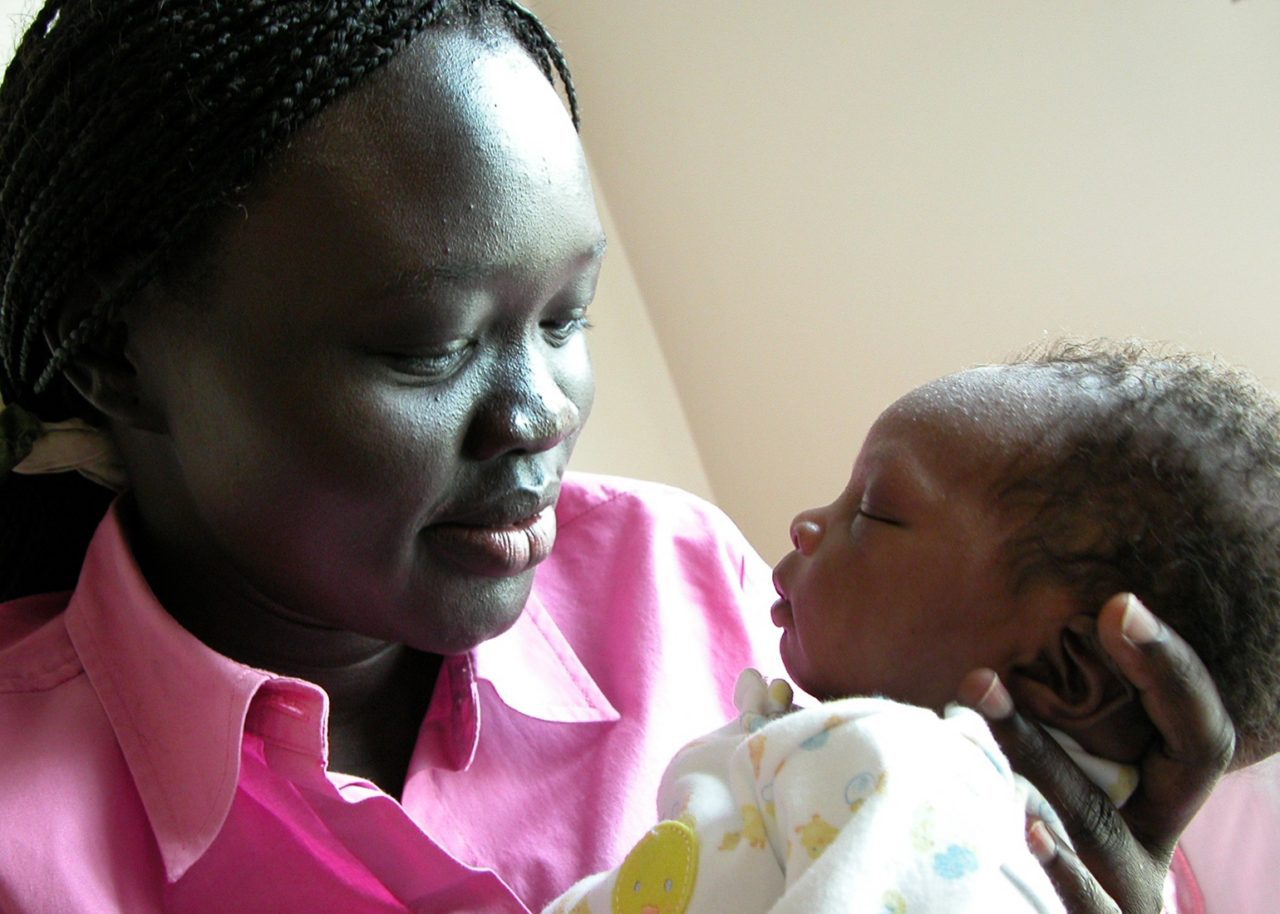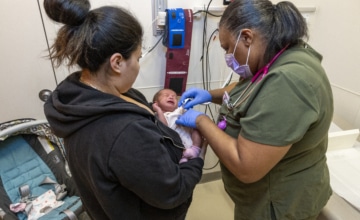Now is the time for federal and state policymakers to secure the best beginnings for babies by ensuring that working families receive paid family leave and paid sick days to support their young children right from the start.

In the first months and years of life, babies discover the world through experiences with their parents and other caregivers. Early relationships, especially with parents, shape the architecture of the developing brain. This critical time in a child’s life is a unique opportunity for parents to attend not only to physical needs—immunization, breastfeeding and nutrition, and adjusting to a new schedule—but also to the time-sensitive developmental tasks of bonding, attunement, and attachment. This formation of secure relationships requires a depth of love for, and knowledge of, a child that only a primary caregiver can come to possess. It takes care, consistency, and, above all, time.
That is why policies to ensure that parents have paid family leave from work to care for their young children are so critical to the healthy development of children and families alike. Unfortunately, very few new parents have paid leave from work. Just 11% of the workforce has time off that is designated as paid family leave, and only about 50% of new mothers take any form of paid time off after the birth of their first child. In a study of 173 countries, the United States was one of only four countries that do not provide paid family leave, alongside Liberia, Papua New Guinea, and Swaziland.
62% of U.S. mothers with infants are in the workforce
While the Family and Medical Leave Act of 1993 (FMLA) guarantees 12 work weeks of job-protected, unpaid leave, one of its limitations is that many American workers are not eligible to take this leave. Although access to unpaid leave is more common than paid leave, many workers who are eligible find it financially difficult, if not impossible, to take leave without pay.
Beyond just the first few months of a baby’s life, parents need time off from work to bring their child to the pediatrician for well-child visits and to seek medical care. Yet, too often, working parents are unable to take leave from their jobs to provide even the most basic care for their infants or young children. Currently, employers are not required to provide their workers with paid sick days and, where they are available, paid sick days can often only be taken to attend to the worker’s own health needs—not to those of a child.
We know that caring, consistent relationships experienced by young children mitigate the impacts of adversity and can mean the difference between positive and negative outcomes, both for children and for our society. In fact, we know that investment in the early years yields savings down the line through crime reduction, increased schooling, workforce productivity, and reductions in teen pregnancy and welfare dependency. Early experiences not only shape individuals but also impact our future citizens, workforce, and parents. By failing to attend to the needs of our youngest children and their parents, we jeopardize our collective future. Now is the time for federal and state policymakers to secure the best beginnings for babies and the best future for our country by ensuring that working families receive paid family leave and paid sick days to support their young children right from the start.
Sorting Out Family Leave Policy
Current National Policy: Family and Medical Leave Act
FMLA (The Family and Medical Leave Act passed in 1993) is the only federal law currently in place that provides family and medical leave. The law allows eligible employees of covered employers to take up to 12 weeks of unpaid, job-protected leave in a 12-month period for specific family and medical reasons, including childbirth, adoption, a child’s serious health condition, and caring for seriously ill family members, including themselves.
The FMLA covers only about half of the workforce. Low-income and part-time workers are less likely to have access to the law’s benefits. More than three in four eligible employees reported that they could not afford to take the leave that they needed because it was unpaid.
Policy Options That Would Increase Parents’ Ability to Support Healthy Early Development: Paid Family Leave and Paid Sick Days
Paid Family Leave gives parents paid time away from work following the birth or adoption of a child, making it feasible for eligible workers to take time off to bond with a new baby or child. The United States is one of only a few countries in the world that does not offer some national form of paid family leave.
Paid Sick Days allow employees to receive paid time to stay home during a short-term illness. While many individual employers include paid sick days in their benefit packages—and although the FMLA ensures access to unpaid leave for serious, long-term illness—the United States does not guarantee access to paid sick days for all workers. In most cases, a parent’s paid sick days cannot be taken to care for other family members, for example, to stay home with a sick child or to take a child to a medical appointment.
Policy Recommendations
1. Expand access to the FMLA to cover more employees.
Because the FMLA applies only to employers with at least 50 employees and requires workers to have been on the job at more than part time for at least one year, about half of the workforce is currently not covered by the federal law. Several states have already passed legislation to extend the law to employers with as few as 10 employees and to even smaller employers for some narrow leave categories. Federal and state policymakers could lower the threshold of employer size from 50 to 25 or even fewer employees. This would allow more working parents to take leave without worrying that they might lose their jobs, giving them the time needed to care for their young children and build the healthy attachments newborns, infants, and toddlers need.
2. Guarantee paid family leave for working families.
While the FMLA provides important protections that have improved conditions for many families, far too many Americans still lack access to any type of family leave. In particular, workers who are low income or in poverty are less likely to have access even to unpaid leave. Even if they do have FMLA benefits, they often cannot afford to take the unpaid time away from work. A national paid family leave policy would provide job security and consistent income during a time when it is essential for parents to bond with a new child or care for an ill family member. There is evidence that such leave policies not only help promote parent–child attachment and improve child health but also improve the economic conditions of families. Federal policymakers should ensure a national paid leave policy that guarantees paid leave for working parents for reasons of childbirth, adoption, a child’s serious health condition, and caring for seriously ill family members, including themselves.
53% of working mothers and 48% of working fathers don’t have paid sick days to care for an ill child.
3. Expand temporary disability or unemployment insurance to help families take paid leave.
In the absence of national paid leave policies, several states have used creative financing mechanisms to allow employees to draw on income while they are on unpaid leave. Specifically, five states—California, Hawaii, New Jersey, New York, and Rhode Island—and the territory of Puerto Rico currently offer temporary disability insurance to provide partial wages to employees who are briefly disabled for medical reasons, including pregnancy and birth-related issues. Just two states, California and New Jersey, allow six weeks of paid leave to care for a new child or a seriously ill family member. To help build the case for a national paid family leave program, state lawmakers should enact legislation guaranteeing that eligible workers who take time off to care for a new child or for a seriously ill child or other relative can collect unemployment insurance or state disability insurance. Allowing wage replacement benefits for these eligible workers helps them to balance the competing interests of work and family while continuing to receive income. To encourage and strengthen states’ leave policies, the U.S. Department of Labor could offer grants to states to establish paid leave programs.
4. Enact a national standard for paid sick days.
Fifty-seven percent of first-time mothers are in the workforce within six months of giving birth, and 64% are working within a year. When parents return to work following the birth or adoption of a child, they do so with a new set of needs and responsibilities. In addition to their own health, they must attend to the health and developmental needs of their baby. Parents require the flexibility to stay home with a sick child. They also need flexibility to take paid leave in small increments to bring their infant to regular well-child medical visits or to attend important meetings pertaining to their child, such as Infant-Family Service Plan meetings for a child with special needs. Currently, paid sick days are not federally mandated, and even those workers who do have access to the law’s benefits often cannot use paid sick days to take care of their children’s health or the medical needs of other family members. Federal policymakers should enact a national standard establishing a minimum number of paid sick days while providing flexibility in workers’ use of paid sick days for themselves and family members. Such a standard is one feasible step toward creating a family-friendly work environment in the United States. Short of a national mandate, federal policymakers can offer model standards through the federal contracting process, promote successful state models, and develop incentives for family-friendly policies.
Research
Infants and toddlers need nurturing relationships in order to thrive.
Babies require positive, consistent care from a loving adult—in most cases, a parent. While quality care can come from a variety of sources, research indicates that, in order to flourish, young children need at least one stable relationship with a responsive caregiver who is dedicated to their well-being. The science of early development tells us that these first relationships are the most enduring influence on a child’s social and emotional development. The formation of a secure attachment is one of the primary developmental tasks in the first year of life and lays the foundation upon which future relationships are built. Positive, consistent relationships during this period yield confident individuals who are better equipped for success in school and in life.
Most fundamentally, we know that it takes months for babies to form secure attachments with their primary caregivers.
The capacity to recognize a caregiver’s voice, smell, and face develops around 3 months of age. Only following this recognition can babies begin to make a connection between that caregiver and a sense of security, comfort, and joy. Increased time off from work gives parents and children the time that is necessary to make these connections, and their ability to do so sets the course for all future development.
Generous periods of leave contribute to the healthy development of infants and toddlers.
Research shows that dedicated time at home with newborns, infants, and toddlers gives parents the time they need to breastfeed, attend well-child medical visits, and ensure that their children receive all necessary immunizations. These practices lower infant mortality and reduce the occurrence and length of childhood illnesses, which in turn reduce private and public health expenditures. Studies show that paid family leave yields higher rates and longer periods of breastfeeding, which reduces the rates of childhood infections and decreases maternal stress. Furthermore, after reviewing family leave policies in 18 countries, researchers found that a 10-week extension in paid leave was predicted to decrease overall infant mortality by 2.6% and post-neonatal (28 days to 1 year) infant mortality by 4%. The U.S. Surgeon General has recommended that paid leave be offered to all working mothers in order to promote breastfeeding.
Nine well-child medical check-ups are recommended in the first year of life, creating a challenge for parents who do not have paid sick days that can be used for this purpose.
Innovative state models show positive results.
California has the country’s most comprehensive paid family and medical leave insurance program, funded through a payroll deduction. More than 13 million workers can receive partial wage replacement (55% of wages) to take up to six weeks of leave a year to care for a newborn, newly adopted or foster child, or seriously ill family member, and up to 52 weeks of leave a year to recover from their own serious illness, including pregnancy- or birth-related disability. A 2011 study of California’s program showed that the law doubled the average amount of time that mothers breastfed. In addition, the overwhelming majority of employers reported positive or neutral effects on productivity, profitability, and morale.
Vulnerable babies have the most to lose.
Because low-income parents are less likely than higher income parents to have access to FMLA benefits—and because they are often unable to afford taking unpaid leave even when it is available to them—the most vulnerable babies are least likely to receive the developmental benefits of leave time. In fact, babies in low-income families face a double jeopardy when it comes to lacking access to quality care: while low-income parents often work multiple shifts and long hours, child care costs can remain prohibitive. The annual cost of full-time, center-based child care for an infant ranges from $4,600 in Mississippi to $15,000 in Massachusetts. Together, the inaccessibility of affordable leave and affordable child care means that too many children in low-income families are deprived of parental care and may not have access to high-quality child care that could support their development. While vulnerable children have the most to lose from a lack of quality care, studies in the field of resilience indicate that they also have the most to gain from its presence.
Paid family leave and paid sick days benefit employers and the economy, now and in the future.
In addition to benefiting employees and their families, leave policies also benefit employers by reducing staff turnover and the subsequent training and hiring costs associated with new staff. These costs can be upwards of 150% of a salaried worker’s annual pay or 50%–75% of an hourly worker’s annual pay. Other benefits include decreased transmission of illnesses among coworkers, increased productivity, fewer absences, and lower overall health care costs. Indeed, lost productivity when employees work while sick—often due to inadequate leave policies—costs the national economy $160 billion each year.




